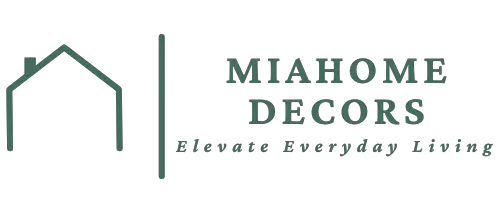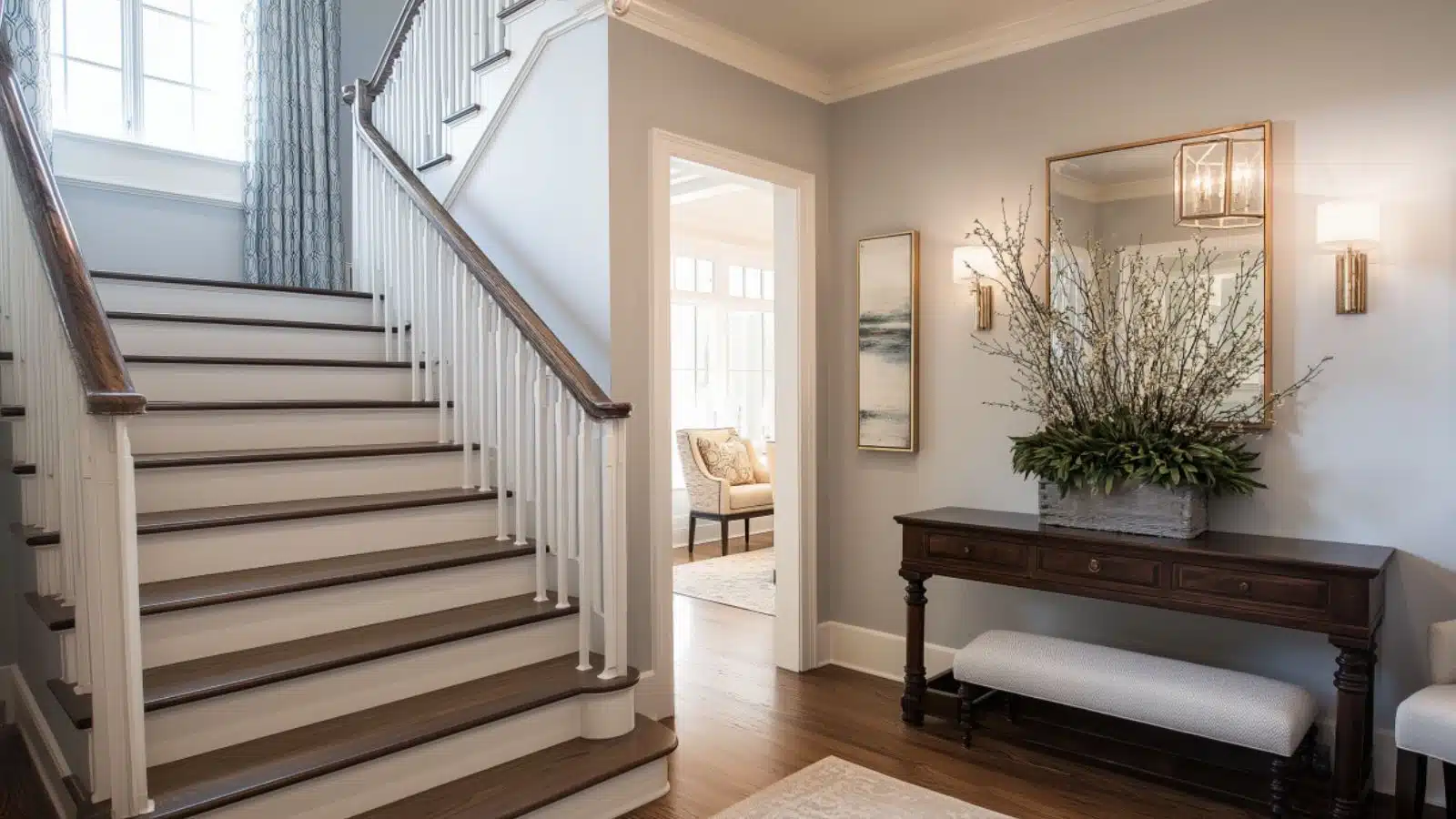Transitional Entry Foyer Design: How to Blend Modern and Traditional Style Seamlessly
Table of Contents
The entryway sets the tone for your entire home—it’s the first impression and often the last space you see as you leave. Designing this area with intention is essential, especially when your style preferences don’t sit squarely in one design box. That’s where transitional entry foyer design comes in—a masterful blend of modern and traditional elements that creates a balanced, welcoming, and timeless aesthetic.
According to interior designers, transitional design remains one of the most popular home decor styles, with homeowners seeking a look that’s refined yet approachable. A transitional entry foyer borrows clean lines and simplicity from modern design while embracing the warmth, detailing, and familiarity of traditional decor. The result is an elegant and functional space that feels curated without being over-styled.
In this article, we’ll walk you through everything you need to know about creating a transitional foyer. You’ll discover how to choose the right color palette, select the ideal furniture and lighting, mix materials effectively, and style your foyer with thoughtful touches. Whether you’re renovating your entry or just giving it a style refresh, you’ll find inspiration and practical tips to design a foyer that gracefully bridges the gap between past and present.
Establishing a Balanced Color Palette for Transitional Appeal
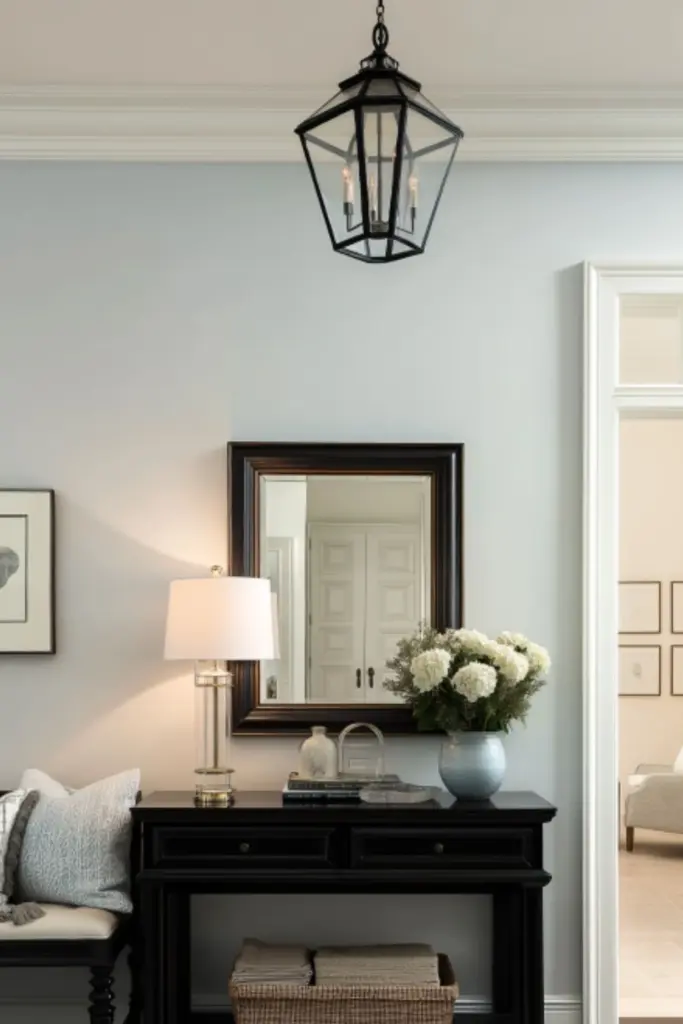
Color is foundational in transitional design—it guides the eye, sets the mood, and acts as a quiet mediator between old and new styles. In a transitional entry foyer, the color palette should lean neutral, warm, and refined. This doesn’t mean bland; it means carefully curated.
Start with base tones like soft white, greige, ivory, or taupe for the walls. These tones offer a blank canvas that allows other elements—like statement lighting or a vintage console—to shine. Introduce contrast with darker hues like charcoal, navy, or espresso through furniture or trim. These grounding shades help anchor the space and bring visual sophistication.
Accent colors should be introduced sparingly and intentionally. Soft muted tones such as dusty blue, sage green, or rust can provide warmth and dimension without overwhelming the space. These can be incorporated through textiles, art, or ceramics.
The overall goal is cohesion and calm—an environment where no one element screams for attention, but everything works together in elegant harmony.
Table: Transitional Color Palette Guide
| Color Type | Example Shades | Best Application Areas |
|---|---|---|
| Base Neutrals | Greige, Cream, Ivory | Walls, ceiling, large furniture |
| Accent Darks | Charcoal, Navy, Espresso | Door trim, console tables, rugs |
| Soft Accents | Dusty Blue, Olive, Rust | Pillows, art, decorative accents |
Selecting Furniture that Blends Classic and Contemporary Styles
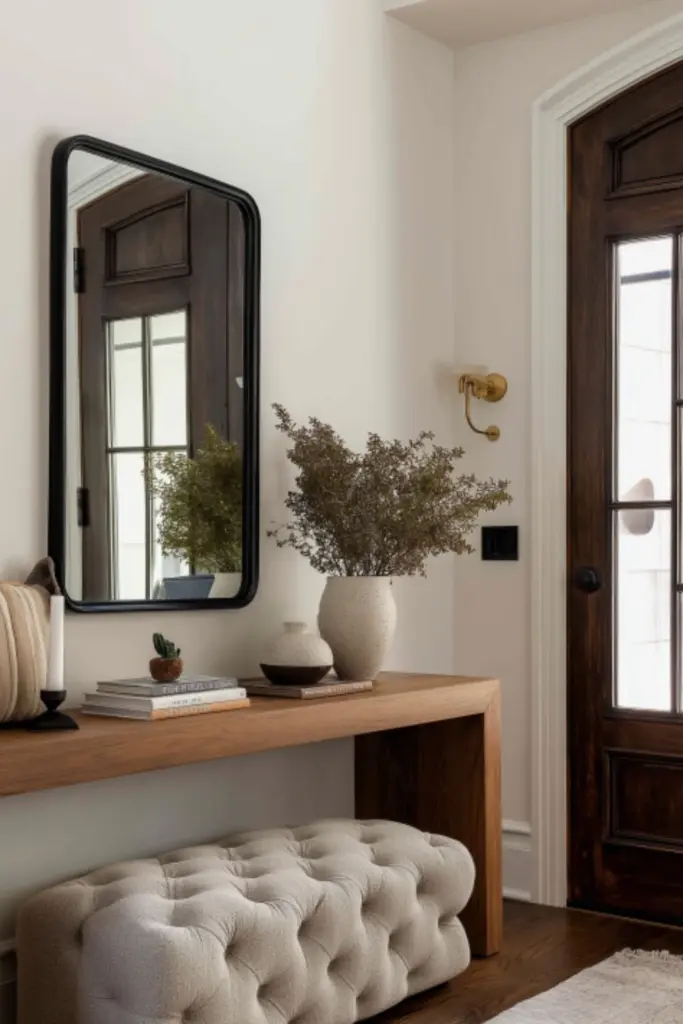
Furniture in a transitional entryway should walk a stylistic tightrope—combining timeless silhouettes with updated details. This ensures the space feels curated, not overly thematic.
A great starting piece is the entryway console table. Opt for a design with clean lines but classic materials. For instance, a walnut console with straight legs offers the richness of traditional furniture but the simplicity of modern design. Likewise, painted or distressed finishes nod to vintage charm without going full antique.
Benches and ottomans provide practical seating and styling opportunities. Look for upholstered benches with neutral fabrics and sleek bases, or tufted pieces with a modern frame. These hybrid designs offer function and flexibility while maintaining the transitional aesthetic.
Don’t forget storage. Entryway pieces should offer concealed or semi-open options like drawers or baskets. A slim sideboard with minimal hardware can act as both a storage hub and a display surface for décor.
Furniture Style Comparison
| Item Type | Traditional Feature | Modern Element | Blended Style Benefit |
|---|---|---|---|
| Console Table | Rich wood finish | Straight or tapered legs | Warm, clean-lined anchor piece |
| Entry Bench | Tufted upholstery | Metal or acrylic base | Soft yet updated visual texture |
| Storage Cabinet | Paneled doors | Streamlined silhouette | Function with elegance |
Layering Materials and Textures for Visual Depth
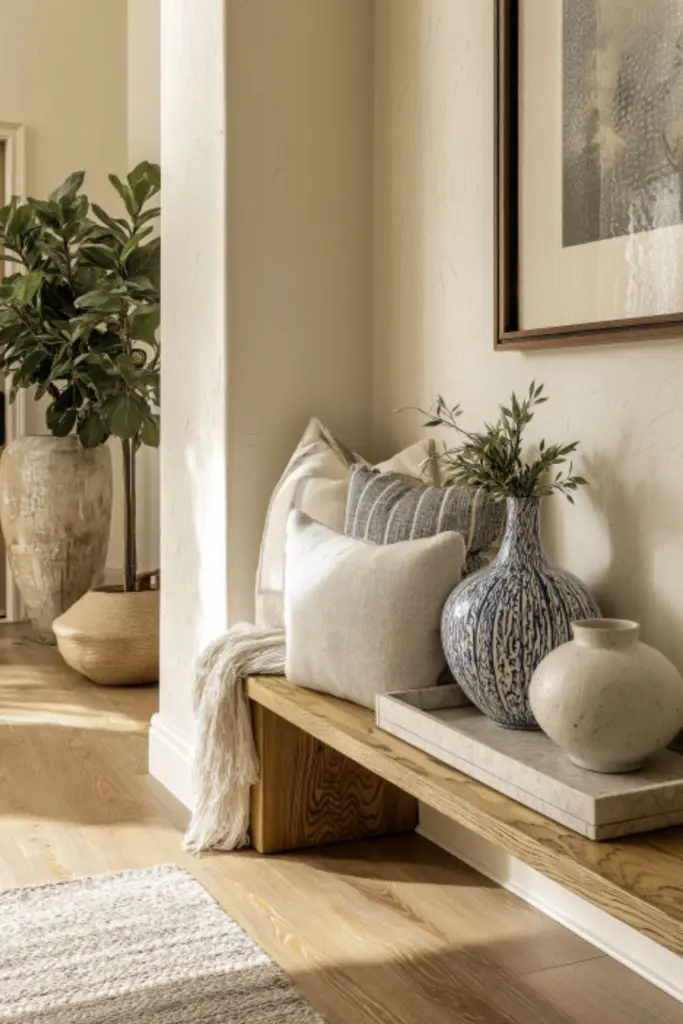
Material contrast is a hallmark of transitional entry foyer design. It’s through this thoughtful layering that spaces avoid feeling flat or one-dimensional. By mixing natural and refined finishes, you add depth and subtle intrigue to what could otherwise be a utilitarian zone.
Start from the ground up. Flooring should reflect the transitional tone—hardwood in warm or medium tones is a classic choice. If your home leans more modern, consider wide-plank oak or even a large-format neutral tile with a matte finish. Add a textural rug to soften the look. A handwoven wool or jute rug introduces organic warmth and complements both modern and traditional furnishings.
Next, bring in a variety of finishes. Pair a dark wood console with a marble or stone tray. Combine a brushed nickel lamp base with a linen or silk shade. These textural differences allow the eye to move naturally throughout the space without visual competition.
Decorative accessories like vases, planters, or trays should offer a tactile quality—ceramic, matte stoneware, leather, or hammered metal all provide richness without excess shine. Keep accessories minimal but meaningful.
Finally, use textiles to your advantage. Drapes near a front door or a throw blanket on a bench can introduce softness. Choose fabrics with subtle patterns or tone-on-tone texture to keep the visual experience cohesive.
Material Layering Table
| Material | Style Influence | How to Use in Foyer |
|---|---|---|
| Warm Wood | Traditional warmth | Console, bench, flooring |
| Metal (Brushed/Matte) | Modern industrial feel | Lighting, mirror frames, décor |
| Natural Textiles | Organic softness | Rugs, curtains, upholstered seating |
| Stone or Marble | Sophisticated touch | Trays, catch-alls, planters |
Using Lighting as a Functional and Decorative Statement
Lighting does more than illuminate a space—it defines it. In transitional entryway design, the right lighting fixture can act as a sculptural focal point while reinforcing your blended style.
The chandelier or pendant light is often the visual centerpiece. Look for pieces that merge classic shapes with contemporary finishes. For example, a lantern-style fixture in matte black, or a globe pendant with brass accents, strikes the perfect balance.
Wall sconces can offer ambient lighting while flanking a mirror or entry bench. Choose options with subtle detailing—perhaps a traditional silhouette with a modern cone shade, or a sleek form with vintage-inspired finishes.
Table lamps on a console bring a layer of cozy lighting. Opt for bases in ceramic, glass, or metal with classic linen shades. Don’t forget the function of lighting here—choose warm bulbs and avoid overly stark white light, which can feel clinical and out of place.
Accent lighting, such as under-console LED strips or candles in hurricane lanterns, creates dimension and a welcoming glow, especially in the evening hours.
Lighting Style Chart
| Fixture Type | Transitional Design Traits | Placement Recommendations |
|---|---|---|
| Pendant/Chandelier | Mixed finishes, classic shapes | Center of foyer ceiling |
| Wall Sconces | Metal or glass with tapered shades | Flanking mirrors or artwork |
| Table Lamps | Ceramic or wood bases with soft shades | On console or sideboard |
| Accent Lighting | Warm LEDs or candlelight | Under furniture, stair landings |
Creating a Functional Layout with Transitional Flow
Designing a transitional foyer isn’t just about aesthetics—it needs to work for daily life. The layout should support movement, storage, and seasonal transitions, all while preserving visual appeal.
Start with traffic flow. Make sure there’s at least 36 inches of clearance for walking paths. Avoid crowding the space with oversized furniture. A console table or narrow bench is ideal for tighter foyers, while larger spaces may benefit from a center table or rug to ground the layout.
Storage should be discreet but effective. Incorporate a slim drawer in your console for keys and mail. Use decorative baskets underneath for shoes or scarves. If space allows, a coat stand or hidden wall hooks behind the door keep outerwear organized without visual clutter.
Consider visual balance. Place heavier furniture against one wall and balance with wall art or a large mirror on the opposite side. If your foyer connects to a staircase, make use of the space beneath the stairs for baskets or a styled vignette.
And don’t forget the rug. A durable, low-pile rug defines the space and adds comfort. Choose a rug that bridges modern and traditional—perhaps a vintage-look pattern in muted colors or a textured monochrome.
Layout Tips Table
| Layout Element | Design Tip | Purpose |
|---|---|---|
| Walking Path | Keep 36” minimum clearance | Allows smooth movement |
| Storage | Use baskets, drawers, or hidden hooks | Maintains clean visual lines |
| Visual Weight | Balance console with mirror or artwork | Creates symmetry and focus |
| Rug Size & Style | Vintage or neutral, fits furniture layout | Defines and softens the foyer |
Styling with Accessories and Personal Touches
Accessories in a transitional foyer should be intentional, layered, and personal. While minimal in number, each piece should add meaning, texture, or visual harmony to the space.
Start with a focal wall—usually above a console table or entry bench. Hang a large, framed mirror with subtle ornamentation or choose a piece of artwork in a neutral or earth-toned palette. Gallery walls can work too, but keep the frames and spacing consistent for cohesion.
On surfaces, stick to a rule of threes. Group accessories like a ceramic vase with dried stems, a decorative bowl for keys, and a stack of hardcover books. Vary heights and finishes to keep it visually interesting but grounded.
Greenery always works. Whether it’s a potted olive tree in the corner or a small fern on a sideboard, organic shapes soften angular furniture and add a fresh touch.
Seasonal updates—like a change of artwork, textiles, or floral arrangements—allow you to refresh the space without major overhauls. For example, in fall, add a rust-hued throw pillow; in spring, switch to a pastel runner rug.
Remember, less is more. Transitional design thrives on balance—never let accessories overwhelm the clean, curated atmosphere.
Accessory Styling Table
| Accessory Type | Transitional Version | Placement & Use |
|---|---|---|
| Wall Mirror | Metal or wood frame with subtle curves | Above console to reflect light |
| Decorative Vessels | Ceramic, glass, or matte stone | On console or side tables |
| Books & Trays | Neutral covers, leather or rattan trays | Surface styling & functionality |
| Greenery | Olive branches, eucalyptus, or fiddle fig | Corners, tabletops, or window ledges |
Conclusion
A transitional entry foyer design blending modern and traditional elements creates a welcoming threshold that speaks to both style and soul. It honors the elegance of traditional decor while embracing the simplicity of modern lines—offering a perfect harmony that feels intentional and timeless.
From neutral palettes and blended furniture to layered textures and purposeful lighting, each detail in a transitional foyer plays a role in balancing the past with the present. With thoughtful planning, your entry can be more than just a pass-through—it becomes a visual prelude to the rest of your home’s story.
